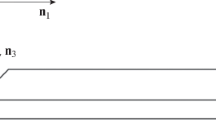Abstract
This paper describes the results of mechanical and optical measurements in plasticized polyvinyl chloride under conditions of creep and relaxation at room temperature. It covers one task of a broader investigation aimed at developing experimental methods for viscoelastic stress analysis.
The moiré method of strain analysis was found well suited for continuous recording of axial and transversal deformation in creep tests.
The material exhibits linear viscoelastic behavior, both mechanical and optical. Strain, stress and birefringence measured from creep and relaxation tests gave straightline plots on log-log scale and, thus simple empirical formulas were possible to derive. The theoretical prediction that birefringence in a linear viscoelastic material not exhibiting flow can be expressed as a linear relationship of stress and strain was satisfactorily substantiated.
Similar content being viewed by others
References
I. M. Daniel, “Two-Dimensional Dynamic Stress Analysis in a Nonelastic Material,”Tech. Doc. Report No. RTD-TDR-63-3059, Air Force Weapons Laboratory, Kirtland Air Force Base, New Mexico;also “Static and Dynamic Stress Analysis in Viscoelastic Materials,” Ph. D. Thesis, Illinois Institute of Technology, Chicago, June 1964.
H. Leaderman, “Elastic and Creep Properties of Filamentous Materials,”Textile Foundation, Washington, D. C., 1943.
T. Alfrey, Jr., “Mechanical Behavior of High Polymers,”Interscience Publishers, Inc., New York, 1948.
J. D. Ferry, “Viscoelastic Properties of Polymers,”John Wiley and Sons, Inc., New York, 1961.
P. S. Theocaris andC. Mylonas, “Viscoelastic Effects in Birefringent Coatings,”Journal of Appl. Mech., 28, 601–607 (1961);also discussion and closure, Journal of Appl. Mechanics, 29, 598–603, 1962.
P. S. Theocaris, “Viscoelastic Properties of Epoxy Resins Derived from Creep and Relaxation Tests at Different Temperatures,”Rheologica Acta, 2, 92–96, 1962.
R. J. Arenz, C. W. Ferguson, T. Kunio and M. L. Williams, “The Mechanical and Optical Characterization of Hysol 8705 with Application to Photoviscoelastic Analysis,” Tech. Doc. Report No. WL TDR-64-4, Air Force Weapons Lab., Kirtland Air Force Base, New Mexico.
J. J. Benbow, “The Determination of Dynamic Moduli and Internal Friction of High Polymers from Creep Measurements,” Proceedings of the Physical Society, LXIX, 885–892, 1956.
S. Morse, A. J. Durelli and C. A. Sciammarella, “Geometry of Moiré Fringes in Strain Analysis,” Proc. of the ASCE, 86, EM4, 105–126, 1960.
C. A. Sciammarella andA. J. Durelli, “Moiré Fringes as a Means of Analyzing Strains,”Proc. of the ASCE, 87, EM 1, 55–74, 1961.
W. F. Riley andA. J. Durell, “Application of Moiré Methods to the Determination of Transient Stress and Strain Distributions,”Jour. of Appl. Mech., 29, 23–29, 1962.
R. D. Mindlin, “A Mathematical Theory of Photoviscoelasticity,”Jour. of Appl. Phys., 20, 206–216, 1949.
Author information
Authors and Affiliations
Rights and permissions
About this article
Cite this article
Daniel, I.M. Quasi-static properties of a photoviscoelastic material. Experimental Mechanics 5, 83–89 (1965). https://doi.org/10.1007/BF02323212
Issue Date:
DOI: https://doi.org/10.1007/BF02323212




